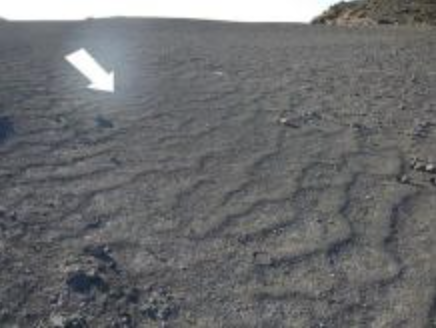It may be hard to tear your eyes away from the spectacular view the cliffs along Cavern Point offer of the Santa Barbara Channel and the coast of California, but if you look down you may observe an ongoing geologic process. The strong offshore winds have formed an interesting pattern of small ripple marks in patches of sediment along Cavern Point. These ripple marks, along with being fun to look at, can be useful in understanding wind direction.

Ripple marks are ridges of sediment that form in response to wind blowing along a layer of sediment. Ripple marks form perpendicular to the wind direction and each ridge is roughly equidistant from the ripple mark on either side. The lack of vegetation at Cavern Point suggests the wind is often very strong, which hinders plant growth, but provides ideal conditions for eolian (wind formed) ripples. The sand and dust are transported by the wind and travel up one side of the ripple and are deposited on the other side.
Ripple marks can be symmetric or asymmetric depending on the dominant direction of the wind. Take a look at the photograph of the ripple marks. If you look closely, you will notice that one side of the ripple has a shallow, gentle incline, while the other is steep and abrupt. These ripple marks are asymmetric, which suggests there is one dominant wind direction. I have added an arrow to the picture to show which direction the wind predominantly blows based on the ripple marks. The wind transports and erodes grains of sediment up along the gentle slope of the ripple mark. Once the sand travels over the ridge, it falls and is deposited on the steep side of the ripple mark. The simple diagram below demonstrates the relationship between the wind and the asymmetric shape of the ripple marks.

The ripple marks found on Santa Cruz Island are very small, but demonstrate the same process that forms the enormous sand dunes seen elsewhere in the world. Next time you are getting buffeted by the wind in an area that is often windy, look around. Chances are good you will see ripple marks.

